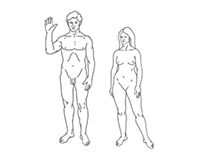A hiccup is a contraction of the diaphragm that may repeat several times per minute. In medicine it is known as ‘synchronous diaphragmatic flutter’ (SDF), or ‘singultus,’ from the Latin ‘singult,’ ‘the act of catching one’s breath while sobbing.’ The hiccup is an involuntary action involving a reflex arc.
Once triggered, the reflex causes a strong contraction of the diaphragm followed about 0.25 seconds later by closure of the vocal cords, which results in the classic hic sound. At the same time, the normal peristalis of the esophagus is suppressed. A bout of hiccups, in general, resolves itself without intervention, although many home remedies are often used to attempt to shorten the duration. Medical treatment is occasionally necessary in cases of chronic hiccups.
Researchers at the Respiratory Research Group at the University of Calgary in Alberta propose that the hiccup is an evolutionary remnant of earlier amphibian respiration. Amphibians such as tadpoles gulp air and water across their gills via a rather simple motor reflex akin to mammalian hiccuping. In support of this idea, they observe that the motor pathways that enable hiccuping form early during fetal development, before the motor pathways that enable normal lung ventilation form. Thus, according to recapitulation theory (proposes that the embryonic development of an individual organism follows the same path as the evolutionary history of its species) the hiccup is evolutionarily antecedent to modern lung respiration. This hypothesis has been questioned because of the existence of the afferent loop of the reflex, the fact that it does not explain the reason for glottic closure, and because the very short contraction of the hiccup is unlikely to have a significant strengthening effect on the slow-twitch muscles of respiration.
A more recent explanation by Howes in 2012 suggests that hiccups may have evolved along with other reflexes developed in mammals that allow them to coordinate suckling milk and breathing. Hiccups are only found in mammals, and are most common in infants, becoming rarer as mammals age. This may suggest that they evolved to allow air trapped in the stomach of suckling infants to escape, allowing more milk to be ingested. The hypothesis suggests that the air bubble in the stomach stimulates the sensory limb of the reflex at receptors in the stomach, esophagus and along the diaphragm. This triggers the hiccup, which creates suction in the chest, pulling air from the stomach up and out through the mouth, effectively burping the animal. This theory is supported by the strong tendency for infants to get hiccups, the component of the reflex that suppresses peristalsis in the esophagus, and the existence of hiccups only in milk-drinking mammals.
Numerous medical remedies exist but no particular treatment is known to be especially effective. Many drugs have been used and various proton-pump inhibitors. Hiccups that are secondary to some other cause like gastroesophageal reflux disease or esophageal webs are dealt with by treating the underlying disorder. Home treatment like drinking water is effective. A simple treatment involves increasing the partial pressure of CO2 and inhibiting diaphragm activity by holding one’s breath or rebreathing into a paper bag. Vagus nerve stimulation can improve hiccups, done at home by irritating the pharynx through swallowing dry bread or crushed ice, or by applying traction to the tongue, or by stimulating the gag reflex. The phrenic nerve can be blocked temporarily with injection of 0.5% procaine, or permanently with bilateral phrenicotomy or other forms of surgical destruction. Even this rather drastic treatment does not cure some cases, however.
In Plato’s Symposium, Aristophanes has a case of the hiccups and is advised by Eryximachus, a physician, to cure them by holding his breath, or, failing that, by gargling or provoking sneezing. This ancient recommendation can be compared with the vagal nerve stimulation.
Hiccups are treated medically only in severe and persistent (termed “intractable”) cases, such as in the case of Jennifer Mee, a 19-year-old woman who, in 2007, hiccuped continuously for five weeks. Haloperidol (Haldol, an anti-psychotic and sedative), metoclopramide (Reglan, a gastrointestinal stimulant), and chlorpromazine (Thorazine, an anti-psychotic with strong sedative effects) are used in cases of intractable hiccups. Effective treatment with sedatives often requires a dose that renders the person either unconscious or highly lethargic. Hence, medicating with sedatives is only appropriate short-term, as the affected individual cannot continue with normal life activities while under their effect.
American Charles Osborne had hiccups for 68 years, from 1922 to 1990, and was entered in the ‘Guinness World Records’ as the man with the longest attack of hiccups an estimated 430 million hiccups later. No sooner was he cured than he died. Briton Christopher Sands had hiccupped an estimated 10 million times in a 15-month period from 2007 to 2009 which were eventually discovered to be due to a tumor on his brain stem had been pushing on nerves, causing him to hiccup every two seconds, 12 hours a day, an affliction that meant that he could hardly eat or sleep and finally stopped in 2009 following brain surgery. In Slavic and Baltic folklore, it is said that hiccups occur when the person experiencing them is being talked about by someone not present. Hiccups in Indian and Arabic folklore are similarly said to occur when the person experiencing them is being thought of by somebody close.
The Daily Omnivore
Everything is Interesting



Leave a comment